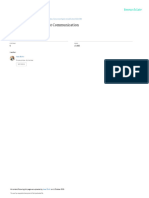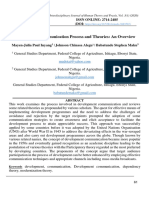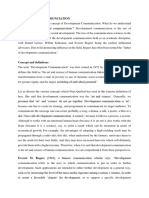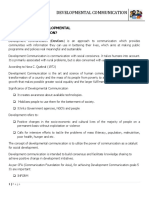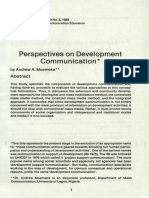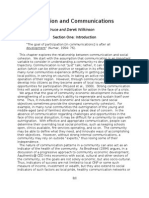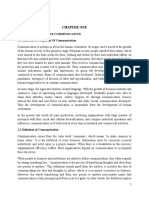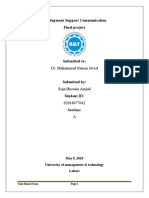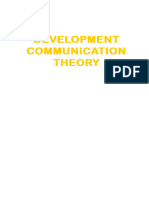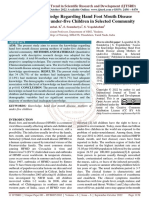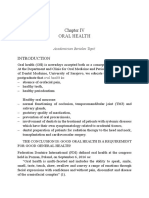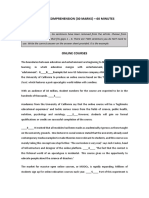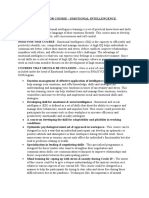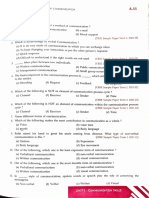Development Communication Theoretical Note
Uploaded by
areebasaeed0608Development Communication Theoretical Note
Uploaded by
areebasaeed0608See discussions, stats, and author profiles for this publication at: https://www.researchgate.
net/publication/357281018
Development communication: Theoretical Note
Article · October 2021
DOI: 10.37896/sr8.11/014
CITATIONS READS
0 5,810
2 authors:
Hitaishi Singh Jaya Bharti
Chhatrapati Shahu Ji Maharaj University Kanpur India CSJM University
31 PUBLICATIONS 10 CITATIONS 91 PUBLICATIONS 71 CITATIONS
SEE PROFILE SEE PROFILE
All content following this page was uploaded by Jaya Bharti on 23 December 2021.
The user has requested enhancement of the downloaded file.
Strad Research https://doi.org/10.37896/sr8.11/014 ISSN: 0039-2049
DEVELOPMENT COMMUNICATION: THEORITICAL NOTE
DR. HITAISHI SINGH, ASSOCIATE PROFESSOR, DEPARTMENT OF HOME SCIENCE,
A.N.D.N.N.M.M.(CSJM UNIVERSITY), KANPUR*
DR. JAYA BHARTI, ASSISTANT PROFESSOR, DEPARTMENT OF PSYCHOLOGY,
A.N.D.N.N.M.M.(CSJM UNIVERSITY), KANPUR**
Abstract: Communication is the life line of human existence. In the process of development of
human civilization communication has played a pivotal role. As technological advancement took
place, communication also developed and grew manifold. Initially the role of communication
was restricted to share and express different needs, feelings and emotions leading to
socialization. Its purpose was further extended to convey various information, using it as
medium of entertainment, training, and education. Another important function of
communication was cultural promotion and exchange which was in form of transfer of values,
norms and belief systems, etc. It was off late, especially after modernization and
industrialization when the importance of communication as a tool for development of society
and welfare of people was realized. At this stage, functions of communication such as
integration, influencing, convincing, awareness generation, persuasion for innovation adoption,
advocacy, debate and discussion for change at various national and international platforms
came at the forefront.
Keywords: Communication, Developmental Communication, Awareness etc.
Communication is simply the act of transferring information from one place, person or group to
another.
Every communication involves (at least) one sender, a message and a recipient. This may sound
simple, but communication is actually a very complex subject. The transmission of the message from
sender to recipient can be affected by a huge range of things. These include our emotions, the cultural
situation, the medium used to communicate, and even our location. The complexity is why good
communication skills are considered so desirable by employers around the world: accurate, effective
and unambiguous communication is actually extremely hard. There is an array of welfare issues that
still remains a major challenge and can be well addressed by the strategic use of communication in
new global development paradigm. Fighting poverty, ensuring food and nutrition security, bringing
modernization, providing better quality of life, inclusive and sustainable development and livelihood
generation are few to name from the list.
Basic difference between communication and development communication
There is a significant difference between every day communication and development
communication. In simple words, every day communication is a process of merely transmitting
messages to inform and make people aware through interchange of thoughts, opinions or information.
It uses verbal or non- verbal methods for the purpose. However, the development communication
aims at bringing a systematic, visible and sustainable social change. This also involves engaging
stakeholders and assessment of situation as crucial step.
Origin and History of Development Communication
Development communication as a practice came into being during 1940s, especially after
World War II. The advent of development communication as an academic science and as an engine
for change and growth was led by scientists like Daniel Lerner, Wilbur Schramm, E.M. Rogers, D.
Lawrence Kincaid, etc. However, its recognition and value as an academic discipline and wide spread
use at field level in agriculture and other areas for bringing change and promoting adoption of new
technologies started 1950 onwards.
VOLUME 8, ISSUE 11, 2021 137 http://stradresearch.org/
Strad Research https://doi.org/10.37896/sr8.11/014 ISSN: 0039-2049
Wilbur Schramm (1964) was the first to recognize the important role that can be played by
communication in national development of the third world countries.22
Though the very first definition of Development Communication (DevCom) was articulated
by Nora Cruz Quebral but she in 1971 (Bessette 2006; Manyozo, 2012), as well as other early
scholars and communication practitioners wrote about use of development communication in practice
as a field of communication with a transformative view without labelling it with DevCom or any other
name. 7
It was extensively used in research and practice related to adoption of medicines, health practices and
family planning activities. However, the term ‘Development Communication’ was first coined by
Nora Cruz Quebral in the year 1972.3,6 Nora Cruz Quebral is often referred as the ‘mother of
development communication’ for giving birth to an academic discipline and training many scholars in
the field.6 Nonetheless, she has clearly reported that Development Communication was first
articulated on 10 December 1971 at the University of Philippines in Los Banos (UPLB). 2 The term is
also popularly called as ‘Dev Com’.
A. Development Communication across Globe
Historically, development communication was used in ‘Post World War II Aid Programmes’
to the countries of Asia, Africa and Latin America with the expectation to equate development as it
has been in western or developed countries. The aim was to help the struggle against poverty, hunger,
illiteracy, economic crisis, poor health and to support building health, social and political
infrastructure in these third world countries.4
First attempts towards development communication can be traced back to Canada, which was
initiated in response to the ‘Great Depression’ and ‘need for increased food production in World War
II’. Under this initiative, farmers met in groups each week from 1941 to 1965 and listened to a special
radio programme at Farm Radio Forums. Here, printed materials and pre- prepared questions were
used to encourage group discussion. These forums also dealt with social and economic issues. This
model was later replicated in India and Ghana.
Soon after World War II modernization paradigm appeared in 1949. In 1950s and 1960s the
western model predominated. As its influence was dominant in the field of development therefore,
this period was named as ‘Dominant Paradigm’ by E. M. Rogers in 1976. In other words, ‘Dominant
Paradigm’ may be referred as ‘a set of values or system of thoughts considered most standard and
held widely at a given time’ and hence they are shaped by the context of that moment or history of
that time as well as by the cultural background of the respective community.19,20 Daniel Lerner and
Wilbur Schramm (1964) supported the dominant paradigm and advocated automation and technology
for development and change.10
In 1950s for development communication the ‘dominant paradigm’ meant-
‘Industry’ as primary influencer,
‘Need of Specialist’ by the modern society,
‘Education’ as major player in governance,
‘Persuasion’ and ‘use of mass media’ to convince and disseminate the messages,
‘Diffusion of Innovation’ leading to adoption of new idea by its beneficiaries
‘Trickle Down Approach,’ i. e., dissemination of profits from centre to the periphery’.
Next important mile stone was establishment of ‘Radyo DZLB’, the community broadcasting
station of UPLB College of Development Communication in 1964. The College is forerunner of
‘School- on- Air (SOA)’ concept. SOA provided nonformal education to rural communities around
Los Banos covering content on nutrition, cooperatives and pest management.
VOLUME 8, ISSUE 11, 2021 138 http://stradresearch.org/
Strad Research https://doi.org/10.37896/sr8.11/014 ISSN: 0039-2049
During 1970s ‘Instructional Television’ was started with improving and making teaching
material relevant in El Salvador to make primary education better. This resulted into increased
graduation rates and increase in number of children attending schools.
Korea’s Planned Parenthood Federation used ‘Interpersonal communication’ through her
remarkable women leaders of women’s club to lower birth rates and to improve life of villages such
as ‘Oryu Li’ in 1970s.
Use of digital media for communication gave impetus to developmental activities but at the
same time created ‘Digital Divide’ amongst the beneficiaries. Therefore, in response to the ‘Dominant
Paradigm’ a major paradigm shift was brought about that gave stress on -
participation of people in the process of development,
individual involvement for the self-development,
use of local resources for self-reliance, and
understanding and making efforts to eliminate gaps created due to communication between
“Haves” and “Have-nots” in terms of socio-economic status, information and knowledge.
Another big change in intellectual shift was brought by Latin American scholars in early
1970s. These scholars challenged the diffusion model to development communication approach. As
Colle (1989) stated, “Critics of diffusion model were unsettled by its pro- innovation, pre- persuasion,
top- down nature and lack of emphasis on recipient’s input into the development decisions and
processes”.
This new paradigm was characterized by shift towards ‘Participatory Approach’ based on a
frame work of system where emphasis was laid on ‘horizontal communication’ in place of ‘vertical
communication’.
In addition, 1970s was marked with the understanding of much broader perspective than the
‘Dominant Paradigm’ criticizing the concept for giving ‘low priority to agriculture and external
factors; and for supporting central economic planning. This was the period when the real use of
communication for developmental activities was used at a large scale. The new ideology believed that
‘economic gains’ cannot boost behavioural changes, and ‘Gross National Product (GNP)’ is not the
measure of ‘development’. It is quality of life that matters and poverty is equated to the
underdevelopment hence, the role of development communication becomes crucial. During this
period, farmers, poor, deprived, or other disadvantaged groups were directly involved in the
communication process. These people were made part of creation of technology and generation of
new knowledge rather than focusing merely on adoption of innovation.
In 1980s Soyabean recipes were ‘demonstrated’ to the women of Cochabamba Valley,
Bolivia to tackle the problem of malnourishment amongst children through a project of social
marketing.
The U. S. government and D.C. comics launched 600,000 comic books in Albanian featuring
Wonder Women and Superman aimed at teaching children about the precautions to be taken when
find an unexploded land mine post ‘Kosovo Civil war.’
B. Development Communication in India
History of organised use of development communication in India may be seen in rural radio
broadcast of 1940s in regional languages during the British rule. In independent India, the first
organised use of communication for community development was made through massive
developmental projects initiated by the central government in 1950s. Due to low literacy rates in rural
areas at that time, person to person communication as two-way communication medium and radio as a
mass communication medium played significant role in reaching out to the masses. Even later,
addressing development related problems in the country remained a challenge for communication due
VOLUME 8, ISSUE 11, 2021 139 http://stradresearch.org/
Strad Research https://doi.org/10.37896/sr8.11/014 ISSN: 0039-2049
to its huge population which is now over 1.3 billion (130 crores). The next challenge has been and
majority residing in rural area and urban slums. Therefore, development communication in numerous
forms continued to remain highly relevant. All kinds of mass campaigns, entertainment shows,
popular and folk media, public shows, seminars and workshops, group meetings, demonstrations, etc.,
were organised in remote areas and urban slums to support developmental activities. These were also
used to make people aware and make them understand about social development schemes.
Community radio is another important medium that has succeeded in addressing local
problems and giving appropriate solution to people from designated area. It provides a platform to the
villagers to broadcast local issues and has a potential to elicit positive and quick action from local
politician and civil servants.
On 15th September 1959, ‘Doordarshan’ started “Krishi Darshan”. For many years, the
programme concentrated only on agriculture related content through its shows.
SITE (Satellite Instructional Television Experiment) was introduced in the 1975 and
education and development related programmes were made available to 2400 villages in 6 states of
Andhra Pradesh, Bihar, Karnataka, Madhya Pradesh, Orissa and Rajasthan in the country. 22
Print media played key role with the initiation of Five-year Plans for planned development.
Especially, newspapers gave ample coverage to various development programmes and schemes
explaining their importance, main features and the way people can be benefitted by them. They wrote
extensively in form of articles on development themes.
Besides Community radio, All India Radio (AIR) also aired different genre of programmes
propagating messages on development related themes and programmes.
A great deal of use of traditional and folk media was made and found effective in spreading
development messages. Use of local language, and characters to address development needs made this
one of the most successful instruments of communication. ‘Nukkad Natak’ or street plays by group
volunteers and organizing rallies were another successful medium used extensively for development
communication.
Numerous comic books and comic strips were created and developed on sensitive issues like
HIV/AIDS in different regional languages of several states all over country. The idea was to promote
development and bringing social change at larger scale. Many times, these comic books were
prepared by local people addressing their local day- to-day needs and problems so that people could
relate with them well. These and interesting way of pictorial narration were the reasons for the high
acceptance rate of comics. Trainings to rural communicators on use of comic books and strips in
remote areas of North-Eastern States, Rajasthan, Jharkhand, Tamil Nadu were also organised.
These are few examples from several types of use of different communication mediums in
multiple fields in India and across the country. Every day such new experiments are taken up and
success stories are written. Constructive and continuous efforts are made in India for the testing and
adoption of different individual and mix of communication instruments and methodologies for
development and social change.
Philosophy and Goal of Development Communication
There are three main concepts that differentiate development communication from general and every
day communication. These concepts states development communication “Purposive, Value -laden and
Pragmatic” 9 and define the philosophy of development communication.
1. Development communication is ‘Purposive’ communication
DevCom always has some goal and intent with which it is directed towards achieving higher
quality of life for the people of society and bringing planned social change.
2. Development communication is ‘Value - Laden’ communication- This means the
VOLUME 8, ISSUE 11, 2021 140 http://stradresearch.org/
Strad Research https://doi.org/10.37896/sr8.11/014 ISSN: 0039-2049
In the development context, a tacit positive value is attached to what one communicates about the
developmental idea which in response motivates the people for social change. The goal of
development communication in a specific society will be influenced by the ‘ends’ and ‘values’ of
that society.
3. Development communication is ‘Pragmatic’ communication
This means the whatever planning is done and actions are taken with in the periphery of
development communication are based on well thought rational.
Finally, one should never view the goal of development communication purely as bringing
change in economic domain, but also bring change in social, political and cultural domain along
with moral values of an individual. These in turn will enable individual to attain its full potential
and make the life complete and wholesome in terms of quality.
Development Communication - Definitions
There are several definitions of development communication given by different international
organisations and individuals. These are -
An expanded definition of development communication given by Nora Cruz Quebral (1972)
states, “It as an art and science of human communication applied to the speedy transformation
of a country and the mass of its people from poverty to a dynamic state of economic growth that
makes possible greater social equality and the larger fulfilment of the human potential”. 17
Nora Cruz Quebral further modified her definition in 2001 and stated development
communication as, “the art and science of human communication linked to a society’s planned
transformation from a state of poverty to one of dynamic socio- economic growth that makes for
greater equity and the larger unfolding of individual potential”.17
Lent (1977) said that, “Development communication can both be the government
‘Lapdog’ or ‘Watchdog’”. 21
“Development Communication is a development support communication which is a
discipline in development planning and implementation in which more adequate account is
taken of human behavioural factors in the design of development projects and their objectives”
(Erskine Childers).1
“Development communication” may be defined as, “a practice or method of
systematically and strategically applying the principles, theories, processes, and strategies of
communication to bring about planned, focused, sustainable and positive transformation and
social change”. (Hitaishi Singh).22
It is a goal-directed communication with value addition. It is generally used for developing
and under developed countries to address the problems aroused due to modernization and
technological advancement. It is the process of employing available and suitable communication tools
and developing result driven strategies from appropriate theories for realizing advancement of the
society.
Development communication is described as, “An approach of communication which is
aimed at making public policies and programmes real, beneficial and sustainable by providing
communities with information and education that they can use to make their life better,
upgraded and meaningful”.3
In other words, “Dev Com is the science that uses communication as an instrument to
educate, motivate and transform people and their attitudes and values to achieve developmental
goals”. 3
VOLUME 8, ISSUE 11, 2021 141 http://stradresearch.org/
Strad Research https://doi.org/10.37896/sr8.11/014 ISSN: 0039-2049
Melkote and Steeve saw development communication as, “Emancipation Communication”,
aimed at combating injustice and oppression. 13
More recent and comprehensive definitions of development communication are given by the
FAO (Food and Agriculture Organisation), World Bank, and other international organisations.
The World Bank has defined development communication on the basis of clear understanding
of indigenous realities. According to The World Bank “Development communication is an
integration of strategic communication in development projects. It strives for behaviour change
not just information dissemination, education, or awareness raising. While the latter are
necessary ingredients of communication, they are not sufficient for getting people to change
long – established practices or behaviours”.3
“Development communication, as an interdisciplinary field, is based on empirical
research that helps to build consensus while it facilitates the sharing of knowledge to achieve a
positive change in the development initiative. It is not only about effective dissemination of
information but also about using empirical research and two-way communications among
stakeholders”. (Development Communication Division, The World Bank).24
Rome Consensus of World Bank, 2006 states development communication as, “A social
process based on dialogue using a broad range of tools and methods. It is also about seeking
change at different levels, including listening, building trust, sharing knowledge and skill-
building policies, debating and learning for sustained meaningful change. It is not public
relation or corporate communication”.11
“Knowledge and information are essential for people to respond successfully to the
opportunities and challenges of social, economic and technological changes, including those that
helps to improve agricultural productivity, food security and rural livelihoods.” Food and
agricultural Organization (FAO).5
Development Communication thus entails:
1. It recognizes the power of communication as catalyst of change.
2. It acts for information dissemination on development schemes, programmes and projects through
interactivity.
3. It intends to elicit sustainable and positive change (social, behavioural, political, moral,
economic, environmental, etc.,).
4. It uses feedback and reverse communication.
5. It gives equal importance to sustainability issues and economic development.
6. It is purposive communication intended for specific target groups.
7. It allows translation of information into action leading to higher quality of life.
8. It intends to seek and depends greatly on community or people’s participation.
9. It is the process of utilizing communication tools, methods and applicable theories to develop
strategies.
10. It works at multiple levels with multipronged approach with flexible strategies.
In nutshell, DevCom is concerned with the all kind of communication directed effortfully and
continuously towards planned social change.
VOLUME 8, ISSUE 11, 2021 142 http://stradresearch.org/
Strad Research https://doi.org/10.37896/sr8.11/014 ISSN: 0039-2049
The Aim of Development Communication -
The aim of development communication is to find strategies and ways for mobilizing individuals and
masses and subsequently channelizing resources for attaining developmental goals.
Understanding Concept of Development Communication - The Key Elements
The key elements of development communication are-
1. The Third World
It is the Third world (developing and underdeveloped) countries for which the term and concept
of development communication has been chiefly used. Though, this concept was initiated from
today’s developed western world but has been extensively used to bring social, cultural and
economic change in the developing and under developed nation for their upliftment,
modernization and development to bring them at par with developed nations.
2. Objective or Aim
The expected outcome towards which all communication efforts are directed. One need to have
clear understanding of difference between the purpose of every day communication and
development communication that intends to focused and planned change.
3. Communication
It is the ‘driver’ of development. The process or tools of result -oriented communication used for
transformation. They are vehicles through which ‘the intended change’ is brought about.
communication that consciously promotes development.
4. Content
Content of much of this communication contains new technology and addresses social issues.
5. Development Communicator
The person or agency which communicates for development and social change.
6. Audience
The beneficiary, people, community or society that is going to get the benefit of development
communication is termed as ‘audience’ in development communication.
7. Social System
It is an arrangement where interrelated and interlinked groups are joined together to achieve a
common goal. It refers to all types of structures and components that makes a society. These
components can be institutions, individuals, communities, groups, castes or religion.
Main characteristics of development communication (Dev Com)
1. Human Communication
Dev com talks about ‘people’ who are ‘end users’ of communication interventions.
2. Speedy Transformation
Dev Com acts as stimulating force or catalyst for bringing rapid, focused and sustainable social
change.
3. Poverty Alleviation
Dev com gives full focus to rural areas because a larger number underprivileged and poor belong
to and are located in rural and remote areas.
VOLUME 8, ISSUE 11, 2021 143 http://stradresearch.org/
Strad Research https://doi.org/10.37896/sr8.11/014 ISSN: 0039-2049
4. Development – Over all development in human life is the ultimate objective or aim towards
which all specific communication efforts are directed. Development is envisioned on one hand, to
diminish poverty, unemployment and inequality and on the other, to bring equity in all spheres of
life ultimately leading to enhanced quality of life.
5. Empowerment- “It is the act of giving somebody control over their own life or situation they are
in”.15 It ranges from inculcating self-strength to efficiency and capacity building amongst the
underprivileged, downtrodden and suppressed class and category such as poor people, rural
people, women, etc.
The empowerment may be categorized into five types-
a. Social empowerment
b. Educational empowerment
c. Economic empowerment
d. Political empowerment
e. Psychological empowerment
6. Managing ‘People’
Dev Com plays dual roles in managing people. On one hand, it plays key role in motivating
beneficiaries or target audiences to become part of processes leading to change and on the other, it
interacts and coordinates with people who can facilitate speedy transformation and are placed at
influential positions.
BOX- 1
TECHNIQUES OF DEVELOPMENT COMMUNICATION
Techniques used in development communication to achieve ‘Inclusive
Development in all Domains’ are-
1. Disseminating ‘Information’
2. Spreading and Delivering ‘Education’
3. Providing ‘Information’
4. Aiming to Bringing ‘Behaviour Change’
5. Using ‘Social Marketing’
6. Invoking ‘Social Mobilization’
7. Aggressively Utilizing ‘Media Advocacy’
8. Seeking ‘Community Participation’
9. Targeting ‘Positive Social Change’
“The ‘Participatory model’ for social change is mainly a new look at the newly emerging
paradigm in development since it emphasizes the importance of two-way horizontal
communication and need to facilitate the participation of stakeholders in each step for
empowerment. ‘Change is now expected to be defined with the people and not for the people,
VOLUME 8, ISSUE 11, 2021 144 http://stradresearch.org/
Strad Research https://doi.org/10.37896/sr8.11/014 ISSN: 0039-2049
making communication for social change closely aligned with the participatory communication
perspective (World Bank)’”. 24
Schools and Theories of Development Communication
A. Schools of Development Communication
In the past decades different development professionals and development-oriented institutions that
existed in different contexts and have faced quite a lot challenges in the process of development at
large. This gave rise to different schools of development communication at various places. There
are six major schools of development communication that have emerged at different places over
time. 13 These are –
1. Bretton Woods School of Development Communication
2. Latin American School of Development Communication
3. Indian School of Development Communication
4. Los Banos School of Development Communication
5. African School of Development Communication
6. Participatory Development Communication Schools
B. Theories of Development Communication
Today there are varied approaches of development communication. They are based on different
theories developed over the period of time commencing from 1940s. During 1960s several schools of
thoughts propounding different broad groups of theories for the development and communication also
emerged. These may be used as per the need of project and characteristics of target audience. Few of
such important groups of theories from different fields of study that can be used successfully to meet
development objectives are -
1. Economic Theories
This was the time when speedy economic growth was taking place world over due to
modernization and industrialization in underdeveloped and developing countries. Hence,
different economic theories as a model for development were propounded during this period.
2. Psychological Theories
Accelerated socio -cultural transition due to migration and changed situations led to the creation
of critical and complex conditions before the people. This led to the development of many
psychological theories.
3. Political Theories
Political will of the leadership is crucial for bringing change in the life of citizens of any nation.
Looking at the demand of the time, political theories were created mainly to fulfill the purpose
of convergence from underdeveloping to developing and from developing to developed nations.
4. Communication Theories
As a vehicle of transformation several communication experiments were carried out by
sociologists, anthropologists and communication experts of that time. As a result, a number of
models and theories were proposed, tested and developed during this period to speed up the
pace of positive social change.
5. Social Marketing Theory
This theory proposes exhaustive and extensive the use of established advertising platforms and
techniques for the development projects.
VOLUME 8, ISSUE 11, 2021 145 http://stradresearch.org/
Strad Research https://doi.org/10.37896/sr8.11/014 ISSN: 0039-2049
6. Some other theories are
a. Diffusion of Innovation Approach
b. Advocacy Theories
c. Entertainment Theory
BOX- 2
MODES OF DEVELOPMENT COMMUNICATION
There are two modes of application of communication theories and
tools in development communication-
A. Monologic Mode
1. It is mainly used in ‘diffusion approach’.
2. It is based on ‘transmission model’ and ‘Diffusion of
Innovation’ theory.
3. It follows one-way communication process.
4. Here the communication process is used to disseminate
information, send message, and raise awareness for attaining
behaviour change.
B. Dialogic Mode
1. It mainly uses ‘participatory approach’.
2. It ensures that voice of each stakeholder is heard
3. It is a two-way communication process.
4. Here the communication process is used to exchange
knowledge, change or create new perception, built trust,
develop mutual understanding and assess strengths,
weaknesses, risks and opportunities.
Understanding Commonly used ‘Terms’ in Development Communication
One must have a clear understanding of certain important terms before coming to the definition of
term ‘Development Communication’. these are -
1. Development
“Development is the process that involves not only changes in economic structures but also
positive multipronged advancement in physical facilities, and progression in entire political,
social and cultural fabric of family, community and society”.
2. Sustainable Development
“Sustainable development is the process of maximizing the use of available resources in order to
ensure availability of these resources for forthcoming generations and assuring long term
wellbeing of future beneficiaries”. For this. such social systems and institutions are developed that
VOLUME 8, ISSUE 11, 2021 146 http://stradresearch.org/
Strad Research https://doi.org/10.37896/sr8.11/014 ISSN: 0039-2049
are based on the philosophy of progressive yet constructive and ecological sustenance. It entails
three major ingredients-
a. Economic Sustainability
b. Social Sustainability
c. Cultural Sustainability
3. Community or People’s Participation
This may be understood as a process where people voluntarily take part in all steps of
development procedure of any activity as well-informed, properly trained and equipped,
motivated individuals or groups of community. The objective of involvement in all types of
developmental activities is to propel the process of development communication and thereby
attaining maximum out of it.
Prerequisites for Effective and Successful Development Communication
There are certain pre- requisites for development Communication to take place -
1. There has to be human and localized approach
2. Establishing and ensuring credibility of communication links
3. Defining roles of communication links
4. Access to Communication sources, methods and tools.
Role of a Development Communicator-
Since the acceptance of any information, development process or communicated content is
the ultimate objective of development communication therefore the role of communicator becomes
extremely important for the whole process. The way development communicator communicates
decides the outcome of the communication and response of the common people. Therefore, to get a
positive response the development communicator should -
have clear understanding of the process of development,
have good knowledge of the process of communication in development process,
possess sufficient command over various communication methods, tools, and professional
techniques and their efficient usage,
know weaknesses and strengths of audiences and understand them well,
built rapport with the people in such a way that people identify the communicator as a part of their
community, society and nation.
have ability and competency to prepare, distribute the message and material in a way that it is
welcomed and received with positive node by the millions of target people. Also, these massages
and materials are accepted and applied with their intended meaning.
be able to mobilize human and subsequently other resources for prompt transition.
The ‘Five Key Words’ of development communication
There are five key words in development communication.13 These are -
1. Dialogue
‘Dialogue’ is the most important ingredient associated with development communication in any
kind of programme. It is extremely necessary to engage all stake holders, policy makers,
VOLUME 8, ISSUE 11, 2021 147 http://stradresearch.org/
Strad Research https://doi.org/10.37896/sr8.11/014 ISSN: 0039-2049
programme planners and establish dialogue for successful communication to take place. Multi
stakeholder dialogue is a must to facilitate maximum participation and collective action. It
reduces any kind of Political and logistics related risks, helps in improving implementation plan
and performance of the programme, increases transparency hence, develops mutual trust and give
space to people’s voices and enhances participation.
2. Stakeholders
The second keyword that has tremendous importance is ‘stakeholders’ as they are the backbone of
the process. ‘Participation’ of all the stake holders in development communication is based on
principles and practice of ‘Two -way Communication’. Development communication aims at
empowering stakeholders.
Involvement of the following is essential stakeholders is crucial for successful development
communication process -
Involvement and support of various government development agencies and departments
Involvement and support of various voluntary organisations and educational institutions
Active participation of concerned citizens.
Involvement and support of non-government organizations (NGOs).
Fig. 2 -Participation Ladder of Stakeholders in Development
16
Communication
Source: Courtsey Phukan, N., “Development Communication: The Emerging
Participatory Paradigm”
Many developmental programmes initiated by the government failed just because all the stakeholder
were neither involved nor taken into confidence before launching the programme.
3. Sharing
Generally, issues related to social change are very sensitive in nature and people are suspicious or
avoid talking about them. If all the details are not shared and a transparent approach is not
adopted since the beginning of communication process, the situation becomes difficult to handle.
This may lead to misunderstanding, confusion, distrust or negative attitude of people towards the
VOLUME 8, ISSUE 11, 2021 148 http://stradresearch.org/
Strad Research https://doi.org/10.37896/sr8.11/014 ISSN: 0039-2049
programme. Consequences may also be serious ultimately causing failure of programme or
project. Therefore, two-way cand clear communication is immensely important.
4. Knowledge
Ensuring equitable access to information, knowledge and communication resources of all
stakeholders is another important key point to remember.
5. Mutual Understanding
Any initiative cannot see the light of success unless there is a proper, mutual and shared
understanding of the goals to be achieved amongst the stakeholders. This may be achieved by
establishing a conducive and encouraging environment so that all the stakeholders feel free and
comfortable in sharing their thoughts, actions and views on different aspects of development plan
and its implementation.
Conclusion: Development communication has covered a long journey. In the future course, its utility
and scope will widen and just not remain restricted to pre- defined boundaries. Rather, it is expected
that in coming years many more elements and strategies will emerge to facilitate the process with
utmost effectiveness and broadened span of coverage. This genre of communication seeks to serve the
people with complete transparency and get genuine response.
REFERENCES
1. Childers Erskine, (1966), “Support Communication in Rural development”, 2 nd World Food
Congress, FAO, Rome.
2. Daya, Romal, (July, 2019), “The Filipinos and the Philippines in Nora Cruz Quebral’s
Development Communication Discourse: Strengthening Communication’s Groundedness in a
Nation’s Context”, University of Philippines, IJAPS, Vol. 15, No. 2, p.p. - 143-173.
3. Desai, Mira, K., (12th June, 2016), “Dev com history: Historical perspective”, A slide share.
https://www.slideshare.net/mirakdesai/dev-com-history
4. CALUNIV (2000), “Development Communication”, Online Resource of The University of
Calcutta, West Bengal, India. https://www.caluniv.ac.in/academic/JMC/Study/DC.pdf
5. FAO, “Food and Agricultural Organization”, https://www.fao.org
6. Garcia, Angelo G., (01May, 2007), “St. Scholastica’s College-Manila: Putting Women on the
Pedestal”, Manila Bulletin Online.
7. Gumucio-Dagron and Tufte, T., (2006), “Communication for Social Change Anthology:
Historical and Contemporary Readings, Communication for Social Change Consortium, South
Orange.
8. Joshi Uma, (2001), “Understanding Development Communication”, Dominant Publishers, New
Delhi.
9. Kumar Rajesh, (December, 2011), “Development Communication: A purposive Communication
with Social Conscience – An Indian perspective”, Global Media Journal – Indian edition, Vol-2,
No. -2, p.p.- 1
10. Lerner Daniel, Wilbur Schramm, (1976), “Communication and Change: The Last Ten Years and
Next”, University of Hawaii Press, Honolulu.
11. Mefalopulos, Paolo, (December,2020), “Development Communication Source Book: Broadening
The boundaries of Communication”, The World Bank, Washington D.C., p.p. - 42-42.
https://www.caluniv.ac.in/global-mdia-journal/
VOLUME 8, ISSUE 11, 2021 149 http://stradresearch.org/
Strad Research https://doi.org/10.37896/sr8.11/014 ISSN: 0039-2049
12. Melkote, Srinivas, R. (1991), “Communication for Development in the Third World: Theory and
Practice,” Sage Publications, New Delhi.
13. Melkote, Srinivas, R. & Steeves, Leslie, H. (2001), “Communication for Development in the
Third World: Theory and Practice for Empowerment,” 2 nd Ed., Sage Publications Ltd., London.
14. M. G., (2012), “Defining Social and Behaviour Change Communication (SBCC) and other
Essential Health Communication Terms: Technical Brief” by The Manoff Group, Communication
Initiative Group, manoffgroup.com/documents, p.p. - 1 - 4.
15. Oxford Dictionary, (2020)
https://www.oxfordlearnersdictionaries.com/definition/english/empowerment/
16. Phukan, N., (November, 2009), “Development Communication: The Emerging Participatory
Paradigm”, https://www.devalt.org/newsletter/nov09/of_6.htm
17. Quebral, N.C., (December, 2011), “DEVCOM Los Banos Style”, Lecture deliver by Nora
Quebral Cruz at the Honorary Doctorate Celebration Seminar, London School of Economics
(LSE), University of London.
https://www.lse.ac.uk/media-and-communications/assets/documents/events/past-events/Professor-
Nora-Cruz-Quebral-Dec-2011-lecture.pdf
18. Rogers, E. M., (1964), “Modernization among Peasants” Holt, Rinehart and Winston Inc., New
York
19. Rogers, E. M., (1976), “Communication and Development: Critical Perspective”, Sage
Publications, Beverly Hills.
20. Rogers, E. M., (1989), “Communication and Development: The Passing of the Dominant
Paradigm”, The Empirical School of Communication Research, Communication Research, Vol. 3,
No. 2, p.p.-213-240.
21. R. Jeflyn, (25, June, 2013), “Development Communication”.
https://www.slideshare.net/jeflynrastrollo/development-communication
22. Schramm, Wilbur, (1964), “Mass Media and National Development: The role of Information in
the Developing Countries”, Stanford University Press, Stanford, California.
23. Singh Hitaishi, (2004), unpublished thesis “Impact of Information, Education and Communication
on Reproductive & Child Health Programme for Women in U.P”, submitted to the Department of
Home Science Extension Education, Institute of Home Science, Dr. B.R. Ambedkar University,
Agra, after p.p. – 1-11, 145 - 283.
24. World Bank, https://www.worldbank.org
----------------------------------------
VOLUME 8, ISSUE 11, 2021 150 http://stradresearch.org/
View publication stats
You might also like
- Term Paper: Development Communication: October 2018No ratings yetTerm Paper: Development Communication: October 201814 pages
- Introduction of Development CommunicationNo ratings yetIntroduction of Development Communication4 pages
- Chapter Four Development Communication: ObjectiveNo ratings yetChapter Four Development Communication: Objective7 pages
- Dev Comm History, Concept, Role and PhilosophyNo ratings yetDev Comm History, Concept, Role and Philosophy3 pages
- Communication For Development The Potential of Local CommunitiesNo ratings yetCommunication For Development The Potential of Local Communities9 pages
- 1 Development Communication An IntroductionNo ratings yet1 Development Communication An Introduction5 pages
- Development Communication, Has Been Alternatively Defined As A Type of Marketing100% (1)Development Communication, Has Been Alternatively Defined As A Type of Marketing7 pages
- 1 Terms and Definitions - Handbook of Communication For Development and Social Change - Jan Servaes - Springer Reference, 2020No ratings yet1 Terms and Definitions - Handbook of Communication For Development and Social Change - Jan Servaes - Springer Reference, 202011 pages
- Development Communication (Dev Comm) : Unit 2No ratings yetDevelopment Communication (Dev Comm) : Unit 23 pages
- Unit Development. Communication: StructureNo ratings yetUnit Development. Communication: Structure15 pages
- Development Communication: - Navya SinghNo ratings yetDevelopment Communication: - Navya Singh20 pages
- Chapter One: Overview of Business Communication 1.1 Historical Development of CommunicationNo ratings yetChapter One: Overview of Business Communication 1.1 Historical Development of Communication45 pages
- Q2 DIASS Week 2 Module 2 (Discipline of Communication)83% (6)Q2 DIASS Week 2 Module 2 (Discipline of Communication)30 pages
- Communication and Development PresentationNo ratings yetCommunication and Development Presentation13 pages
- Theory and Practice of Participatory CommunicationNo ratings yetTheory and Practice of Participatory Communication4 pages
- Mass Media and Ict in Development Communication: Comparison & ConvergenceNo ratings yetMass Media and Ict in Development Communication: Comparison & Convergence29 pages
- Jepretan Layar 2023-11-02 Pada 8.19.36 PMNo ratings yetJepretan Layar 2023-11-02 Pada 8.19.36 PM15 pages
- Linking Development and Communication 1No ratings yetLinking Development and Communication 118 pages
- Historical Development of Communication For Development: Okunnu Ganiu ONo ratings yetHistorical Development of Communication For Development: Okunnu Ganiu O18 pages
- Discipline of Communication Deals With How Human Humans Use Verbal and NonNo ratings yetDiscipline of Communication Deals With How Human Humans Use Verbal and Non16 pages
- UNIT 4 Communication Process Extension DPSNo ratings yetUNIT 4 Communication Process Extension DPS35 pages
- Development Communication - An Approach To A Democratic Public Information SystemNo ratings yetDevelopment Communication - An Approach To A Democratic Public Information System6 pages
- Ls1cs/en-L-Psals-1: Ls1cs/en-W-Pse-Ae-33 Ls2sc-As-Psb-Bl/le/ae/ls-7.1 Ls2sc-As-Psf-Bl/le/ae/ls/as-2.3100% (1)Ls1cs/en-L-Psals-1: Ls1cs/en-W-Pse-Ae-33 Ls2sc-As-Psb-Bl/le/ae/ls-7.1 Ls2sc-As-Psf-Bl/le/ae/ls/as-2.34 pages
- Definition and Importance of Manpower Planning100% (1)Definition and Importance of Manpower Planning3 pages
- Jordan Syatt & Mike Vacanti: 30 No-BS Strategies To Get More Online Coaching Clients and Help People All Over The World100% (1)Jordan Syatt & Mike Vacanti: 30 No-BS Strategies To Get More Online Coaching Clients and Help People All Over The World24 pages
- PR1 Manuscript Template With Preliminary Pages 2 Group 4 Borja 1No ratings yetPR1 Manuscript Template With Preliminary Pages 2 Group 4 Borja 115 pages
- Assess The Knowledge Regarding Hand Foot Mouth Disease Among Mothers of Under Five Children in Selected CommunityNo ratings yetAssess The Knowledge Regarding Hand Foot Mouth Disease Among Mothers of Under Five Children in Selected Community4 pages
- CU16 Filipino Cultural Characteristics and Health Care Beliefs86% (7)CU16 Filipino Cultural Characteristics and Health Care Beliefs4 pages
- Outline For Course - Emotional IntelligenceNo ratings yetOutline For Course - Emotional Intelligence2 pages
- Pediatric Radiation Oncology Halperin 1No ratings yetPediatric Radiation Oncology Halperin 1480 pages
- Transforming Stress For Teens The HeartMath SolutiNo ratings yetTransforming Stress For Teens The HeartMath Soluti106 pages
- Anthropometric and Physiological Characteristics.35No ratings yetAnthropometric and Physiological Characteristics.3512 pages
- Pencak Silat Basic Motion Learning Through Tactical Approach For Junior High School StudentsNo ratings yetPencak Silat Basic Motion Learning Through Tactical Approach For Junior High School Students4 pages
- Cue Centered Therapy For Youth Experiencing Posttraumatic Symptoms A Structured, Multi Modal Intervention, Therapist Guide Reference Book Download100% (10)Cue Centered Therapy For Youth Experiencing Posttraumatic Symptoms A Structured, Multi Modal Intervention, Therapist Guide Reference Book Download14 pages
